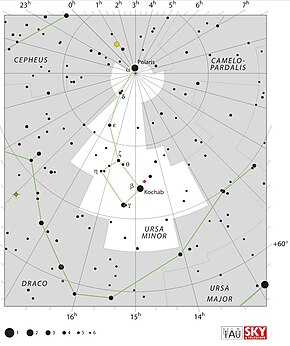Ursids
| Ursids (URS) | |
|---|---|
 Ursa Minor with the radiant of the Ursids marked in red | |
| Parent body | 8P/Tuttle[1] |
| Radiant | |
| Constellation | Ursa Minor (near Kochab) |
| Right ascension | 14h 36m [2] |
| Declination | +75.3°[2] (Northern Hemisphere) |
| Properties | |
| Occurs during | December 17 – December 26[1] |
| Date of peak | December 22[1] |
| Velocity | 33[2] km/s |
| Zenithal hourly rate | 10[1] |
The Ursid (URS) meteor activity begins annually around December 17 and runs for over a week, until the 25th or 26th. This meteor shower is named for its radiant point, which is located near the star Beta Ursae Minoris (Kochab) in the constellation Ursa Minor.
History
[edit]The Ursids were probably discovered by William F. Denning, who observed them for several years around the start of the 20th century.[1] While there were sporadic observations after, the first coordinated studies of the shower didn't begin until Dr. A. Bečvář observed an outburst of 169 per hour in 1945.[1] Further observations in the 1970s and ongoing to current have established a relationship with comet 8P/Tuttle.[1] Peter Jenniskens and Esko Lyytinen discovered that outbursts could happen when comet Tuttle was at aphelion because some meteoroids get trapped in the 7/6 orbital resonance with Jupiter.
Technical information
[edit]Earlier observations described an average radiant of RA=217°, DEC=76°,[1] with maximum occurring at a solar longitude of 270.66 deg (about December 22), with the duration being established as December 17–24.
The Ursids have a particularly narrow stream, prompting veteran meteor observer, Norman W. McLeod, III (Florida) to comment that the Ursids "must be a compact stream like the Quadrantids. You have to be within 12 hours of maximum to see much."[1]
References
[edit]- ^ a b c d e f g h i Gary W. Kronk. "Observing the Ursids". Meteor Showers Online. Archived from the original on 2013-07-24. Retrieved 2012-11-17.
- ^ a b c IMO Meteor Shower Calendar: Ursids (URS)

